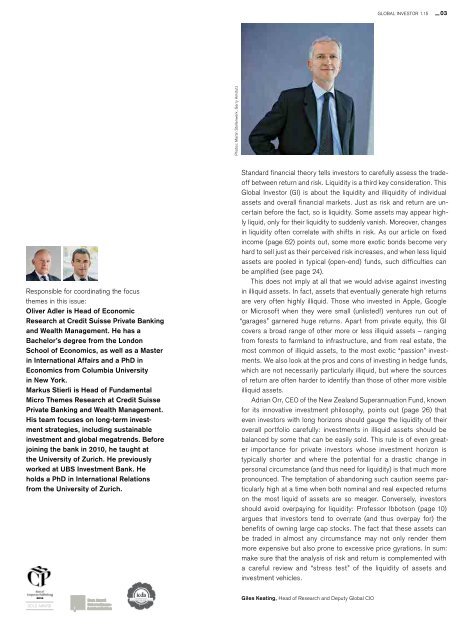Illiquid assets
Unwrapping alternative returns Global Investor, 01/2015 Credit Suisse
Unwrapping alternative returns
Global Investor, 01/2015
Credit Suisse
You also want an ePaper? Increase the reach of your titles
YUMPU automatically turns print PDFs into web optimized ePapers that Google loves.
GLOBAL INVESTOR 1.15 — 03<br />
Photos: Martin Stollenwerk, Gerry Amstutz<br />
Responsible for coordinating the focus<br />
themes in this issue:<br />
Oliver Adler is Head of Economic<br />
Research at Credit Suisse Private Banking<br />
and Wealth Management. He has a<br />
Bachelor’s degree from the London<br />
School of Economics, as well as a Master<br />
in International Affairs and a PhD in<br />
Economics from Columbia University<br />
in New York.<br />
Markus Stierli is Head of Fundamental<br />
Micro Themes Research at Credit Suisse<br />
Private Banking and Wealth Management.<br />
His team focuses on long-term investment<br />
strategies, including sustainable<br />
investment and global megatrends. Before<br />
joining the bank in 2010, he taught at<br />
the University of Zurich. He previously<br />
worked at UBS Investment Bank. He<br />
holds a PhD in International Relations<br />
from the University of Zurich.<br />
Standard financial theory tells investors to carefully assess the tradeoff<br />
between return and risk. Liquidity is a third key consideration. This<br />
Global Investor (GI) is about the liquidity and illiquidity of individual<br />
<strong>assets</strong> and overall financial markets. Just as risk and return are uncertain<br />
before the fact, so is liquidity. Some <strong>assets</strong> may appear highly<br />
liquid, only for their liquidity to suddenly vanish. Moreover, changes<br />
in liquidity often correlate with shifts in risk. As our article on fixed<br />
income (page 62) points out, some more exotic bonds become very<br />
hard to sell just as their perceived risk increases, and when less liquid<br />
<strong>assets</strong> are pooled in typical (open-end) funds, such difficulties can<br />
be amplified (see page 24).<br />
This does not imply at all that we would advise against investing<br />
in illiquid <strong>assets</strong>. In fact, <strong>assets</strong> that eventually generate high returns<br />
are very often highly illiquid. Those who invested in Apple, Google<br />
or Microsoft when they were small (unlisted!) ventures run out of<br />
“garages” garnered huge returns. Apart from private equity, this GI<br />
covers a broad range of other more or less illiquid <strong>assets</strong> – ranging<br />
from forests to farmland to infrastructure, and from real estate, the<br />
most common of illiquid <strong>assets</strong>, to the most exotic “passion” investments.<br />
We also look at the pros and cons of investing in hedge funds,<br />
which are not necessarily particularly illiquid, but where the sources<br />
of return are often harder to identify than those of other more visible<br />
illiquid <strong>assets</strong>.<br />
Adrian Orr, CEO of the New Zealand Superannuation Fund, known<br />
for its innovative investment philosophy, points out (page 26) that<br />
even investors with long horizons should gauge the liquidity of their<br />
overall portfolio carefully: investments in illiquid <strong>assets</strong> should be<br />
balanced by some that can be easily sold. This rule is of even greater<br />
importance for private investors whose investment horizon is<br />
typically shorter and where the potential for a drastic change in<br />
personal circumstance (and thus need for liquidity) is that much more<br />
pronounced. The temptation of abandoning such caution seems particularly<br />
high at a time when both nominal and real expected returns<br />
on the most liquid of <strong>assets</strong> are so meager. Conversely, investors<br />
should avoid overpaying for liquidity: Professor Ibbotson (page 10)<br />
argues that investors tend to overrate (and thus overpay for) the<br />
benefits of owning large cap stocks. The fact that these <strong>assets</strong> can<br />
be traded in almost any circumstance may not only render them<br />
more expensive but also prone to excessive price gyrations. In sum:<br />
make sure that the analysis of risk and return is complemented with<br />
a careful review and “stress test” of the liquidity of <strong>assets</strong> and<br />
investment vehicles.<br />
Giles Keating, Head of Research and Deputy Global CIO

















